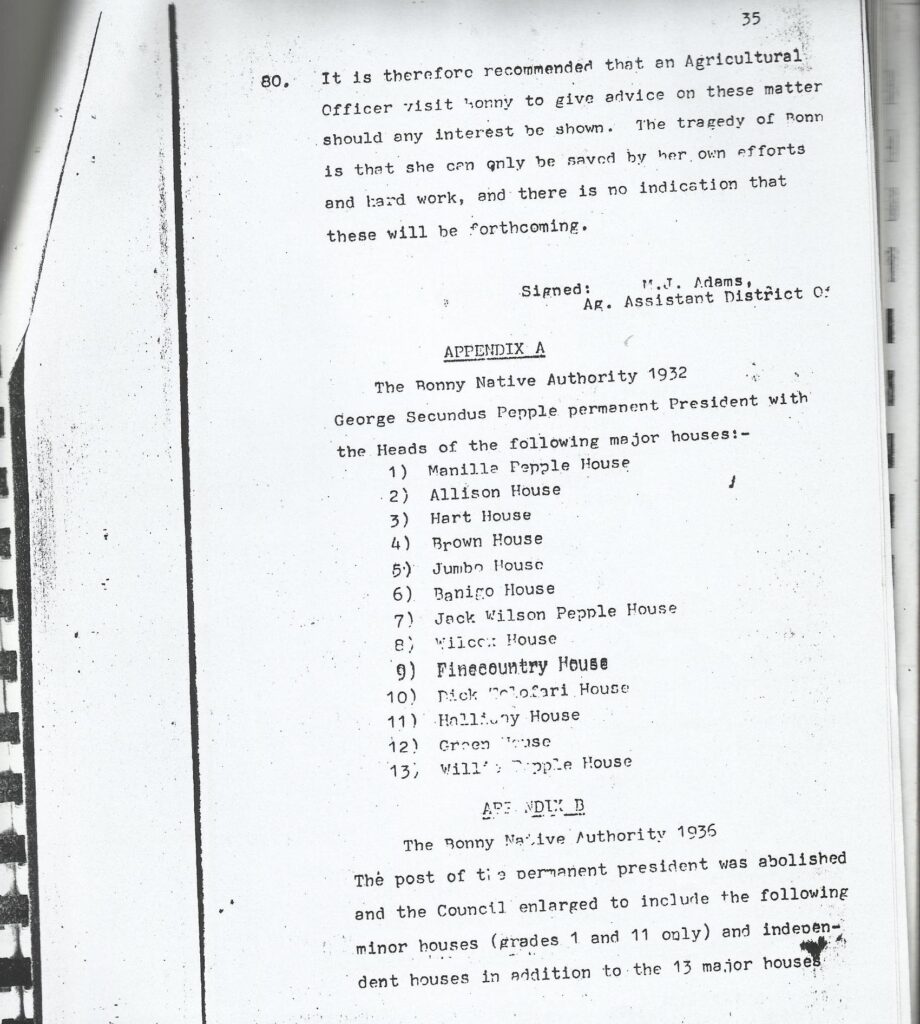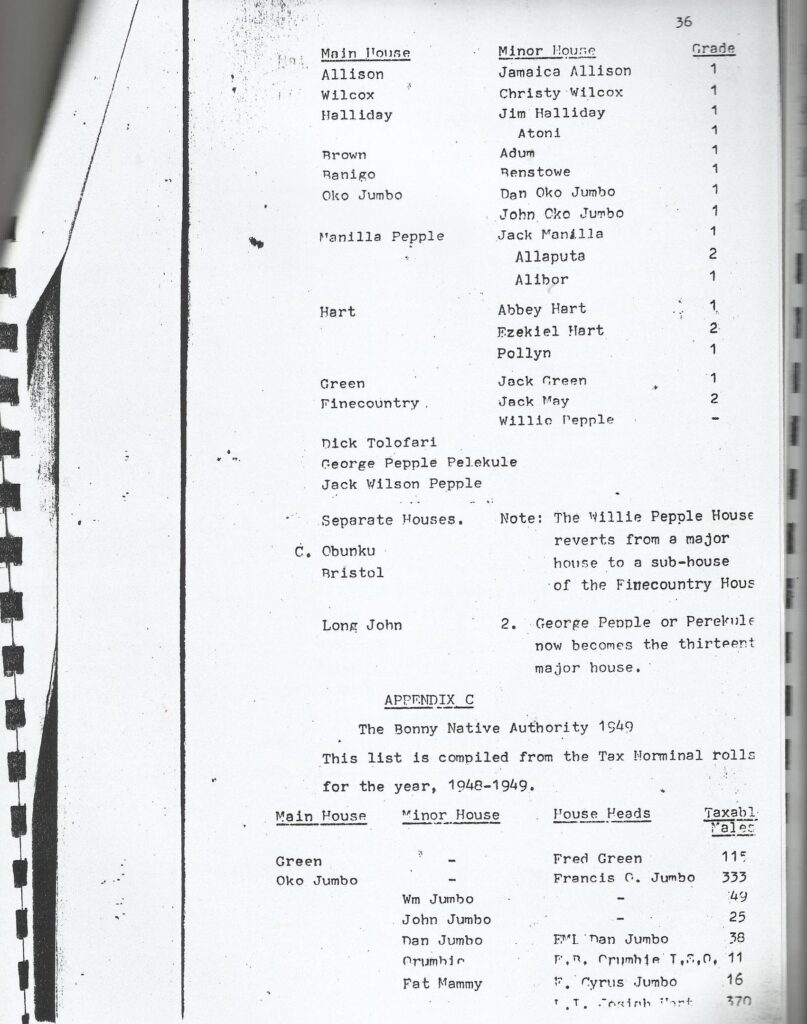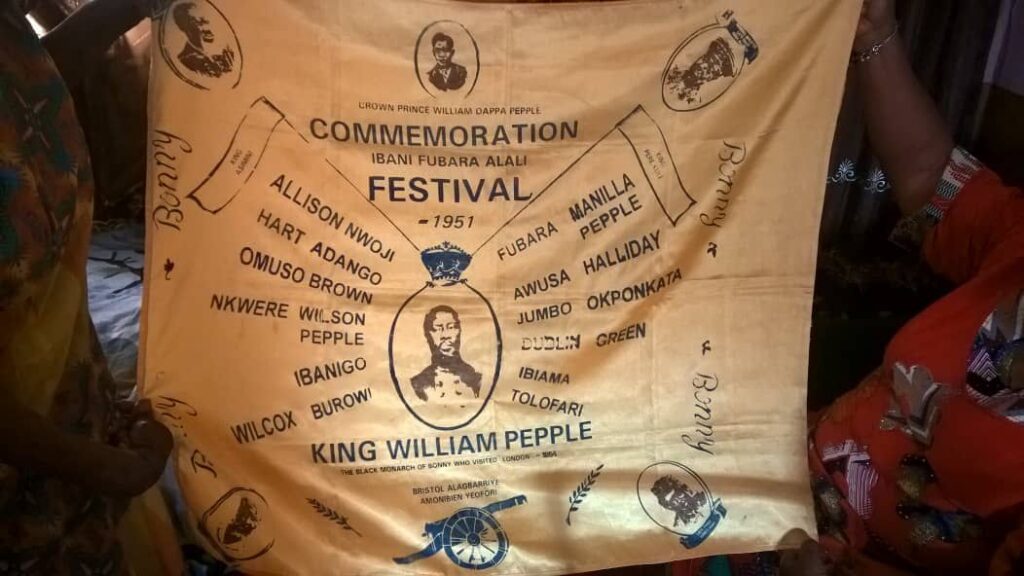Setting the Record Straight: The Indisputable Authority of the Buoye Omuso Brown Royal House Over Finima

By Engr Tamunofiniarisa Brown
The recent resurgence of false narratives regarding the ownership and paramountcy of Finima land compels a comprehensive response to set the historical and legal record straight. Despite repeated judicial vindication spanning over five decades, certain quarters persist in propagating discredited claims that have been thoroughly tested and dismissed by competent courts of law.
The Judicial Foundation: A Pattern of Consistent Victory
The ownership and paramountcy of the Buoye Omuso Brown Major House of Finima is not a matter of opinion or debate—it is established legal fact, confirmed through multiple landmark court judgements that have withstood the test of time and appeal.
The judicial record speaks with unwavering clarity:
PHC/174/1972 – Chief Samuel O. Tobin & Others v. Chief Israel I. Brown & Others (subsequently affirmed on appeal in FCA/E/60/1980): This foundational case established the legal precedent that has guided all subsequent litigation. The court’s comprehensive examination of evidence, customary law, and historical documentation resulted in an unequivocal victory for the Brown House.
PHC/188/2010 – Chief Y.S. Tobin v. Chief Yibo Buowari Brown & Others: Once again, Tobin House’s challenge to Brown House authority was comprehensively dismissed, with the court reaffirming established legal precedent.
PHC/745/2012 – Chief Young Sunday Tobin & Others v. Mobil Producing Nigeria Unlimited & Others: In this significant case involving major petroleum interests, the court once again recognised Brown House paramountcy over Finima land.
FHC/ABJ/CS/1419/2022 – Buoye Omuso (Brown) Major House v. Federal Minister of Petroleum Resources & Others (decided 15 September 2023): This recent Federal High Court judgement represents the most comprehensive judicial pronouncement to date, definitively establishing Brown House rights in the modern legal framework.
These are not isolated victories or technicalities—they represent a consistent judicial recognition spanning over fifty years of litigation. Every attempt to challenge Brown House authority has failed comprehensively, with courts repeatedly affirming what customary law and historical evidence have long established.
Historical Foundations: The True Origins of Finima
To understand the contemporary legal position, one must appreciate the historical foundations upon which these judgements rest. Finima’s origins are inextricably linked to the Buoye Omuso Brown Royal House, one of the ancient Duawari (aboriginal founding houses) of Bonny Kingdom.
The Buoye Omuso Brown Royal House represents one of the five Aboriginal Founding Houses of Bonny, distinguished by their Duawari status—a designation that carries profound historical and customary significance. This ancient lineage established Finima as their ancestral domain, nurturing and developing the community over generations.
The historical record of the relocation from Old Finima provides compelling demographic evidence of this authority. When the community transitioned to its present location, the distribution of buildings and inhabitants told an unambiguous story: Tobin House possessed barely a dozen structures, Attoni House managed slightly over twenty, whilst the overwhelming majority—the heart and substance of the community—belonged to the Buoye Omuso Brown Royal House. These figures reflect not mere numerical superiority, but the fundamental reality of ownership and stewardship that had evolved over generations.
Contemporary demographic analysis confirms this historical pattern. The Buoye Omuso Brown House (BOBH) family constitute 99% of Finima indigenes, who can trace their roots to BOBH including the Adum (Tamunobere), Attoni and Tobin. Actually, the Adum (Tamunobere), Attoni and Tobins are offshoots or minor Houses/family groups from the BOBH. This remarkable statistic demonstrates that even houses now claiming independent status originated as branches of the Buoye Omuso Brown Royal House—a fact that utterly destroys any claim to separate ownership or authority.
Addressing the “Evidence”: Chronological Impossibilities and Legal Irrelevance
Recent attempts to challenge established authority have relied heavily on what can only be described as “chimney documents”—aged correspondence and dubious paperwork that cannot withstand scrutiny. The latest example—a purported 1940 letter involving Isaac Sonye Brown and one O. S. Tobin (Owunabo Samuel Tobin)—exemplifies the fundamental flaws in these challenges.
The chronological impossibility alone renders this document suspect: the letter allegedly shows correspondence with O. S. Tobin in 1940, yet historical records confirm he was not installed as chief until 1961—twenty-one years later. How does one conduct official correspondence with a non-chief regarding land allocation? The premise defies both logic and established customary protocol.
The Devastating 1939 Affidavit: Tobin House’s Own Admission
Perhaps the most damning evidence against contemporary Tobin House claims lies in their own historical record. In 1939, Owunabo Samuel Tobin (O. S. Tobin) signed an affidavit explicitly acknowledging that Finima belongs to the Buoye Omuso Brown Royal House. This document, created by Tobin House’s own ancestor, represents an unequivocal admission of Brown House ownership and authority.
The implications of this 1939 affidavit are devastating to any subsequent Tobin House claims:

Legal Precedent: In law, admissions against interest carry exceptional weight. When Tobin House’s own predecessor formally acknowledged Brown House ownership, it created binding precedent that cannot be simply wished away by later generations.
Historical Authenticity: Unlike the dubious 1940 correspondence, this 1939 affidavit represents genuine historical documentation, created without the pressure of litigation or contemporary disputes. It reflects the honest recognition of established authority as understood at the time.
Chronological Consistency: The affidavit pre-dates any serious challenge to Brown House authority, making it an authentic reflection of traditional understanding rather than revisionist interpretation.
Judicial Recognition: This affidavit has undoubtedly been examined in the multiple court cases spanning five decades. Its existence and contents would have informed judicial decisions consistently favouring Brown House authority.
The attempt to present the 1940 correspondence as legitimate evidence becomes not merely chronologically impossible but legally absurd when viewed against the 1939 affidavit. How does one explain away their ancestor’s formal recognition of Brown House ownership, then claim he received land applications as the rightful authority just one year later?
This represents the complete collapse of any coherent Tobin House narrative regarding Finima ownership.
The Adams Intelligence Reports: Official Colonial Documentation Exposes the Truth
Perhaps the most authoritative refutation of Tobin House claims comes from official British colonial intelligence reports compiled by Agricultural Assistant District Officer W.J. Adams between 1932 and 1949. These comprehensive administrative documents, created for taxation and governance purposes, provide an unassailable official record of Bonny Kingdom’s house structure during the critical period when Tobin House now claims to have held authority.

The 1932 Bonny Native Authority Report lists thirteen major houses recognised by the colonial administration:
- Manila Pepple House
- Allison House
- Hart House
- Brown House
- Jumbo House
- Banigo House
- Jack Wilson Pepple House
- Wilcox House
- Finecountry House
- Dick Tolofari House
- Halliday House
- Green House
- Willie Pepple House
Tobin House is conspicuously absent from this official colonial record.



The 1936 Report shows the same major houses, with Brown House prominently listed alongside established major houses, whilst minor houses and sub-houses are clearly categorised separately. Again, no mention of Tobin House exists in any capacity.
The 1949 Tax Nominal Rolls provide the most detailed breakdown, showing:
- Brown House: 125 taxable males (one of the largest populations)
- Attoni (listed as a minor house under Brown): 8 taxable males
- Major houses like Hart, Manila Pepple, Halliday, Allison all clearly enumerated
- Complete absence of any “Tobin House” designation
Critical Analysis of This Evidence:
- Official Recognition: These are not informal documents but official colonial administrative records used for taxation, governance, and legal purposes. The British colonial administration had compelling reasons to accurately identify all recognised houses for administrative efficiency.
- Comprehensive Coverage: The reports meticulously list major houses, minor houses, sub-houses, and even houses that had “broken away” from major houses. The systematic nature of this documentation makes any omission highly significant.
- Chronological Consistency: Across seventeen years (1932-1949), during the height of the colonial period when house structures were being formalised, Tobin House receives no recognition whatsoever.
- Demographic Reality: The Brown House’s 125 taxable males in 1949 represents one of the largest house populations in Bonny Kingdom, confirming their major house status and substantial community presence.
- Contemporary Context: These reports were compiled during the very period when O.S. Tobin would have been active (remember his 1939 affidavit acknowledging Brown House ownership of Finima). If he possessed the authority Tobin House now claims, why does no colonial record acknowledge his house’s existence?
The Impossible Timeline Revisited:
- 1932-1949: No official recognition of Tobin House in comprehensive colonial administrative records
- 1939: O.S. Tobin signs affidavit acknowledging Brown House ownership of Finima
- 1940: Alleged correspondence showing Isaac Sonye Brown applying to O.S. Tobin for land
- 1961: O.S. Tobin becomes chief
The colonial records expose the fundamental impossibility of Tobin House claims. How can a house that received no official recognition throughout the entire colonial administrative period suddenly claim historical authority over Finima? How can someone who signed an affidavit acknowledging Brown House ownership in 1939 be portrayed as the rightful authority receiving land applications in 1940?
Legal and Historical Implications:
These colonial intelligence reports represent contemporaneous official documentation created without any knowledge of future disputes. They provide an objective, administrative perspective on house structures that cannot be dismissed as partisan or biased. When combined with the 1939 affidavit and consistent court victories, they create an evidentiary foundation that renders any Tobin House challenge not merely weak, but historically impossible.
The Adams Intelligence Reports don’t just support Brown House authority—they completely demolish any pretence of historical legitimacy for alternative claims.
More importantly, even if such correspondence were genuine, it would establish the opposite of what challengers claim. Applications for land allocation do not demonstrate ownership—they confirm the necessity of seeking permission from rightful authorities. Such correspondence would merely reinforce Brown House paramountcy rather than challenge it.
These documents have been presented in multiple court proceedings, examined by qualified judges, and consistently found insufficient to challenge established rights. The judiciary’s repeated rejection of such evidence speaks volumes about their legal relevance.
The Duawari Distinction: Understanding Traditional Hierarchy
Central to understanding this matter is the significance of Duawari status within Bonny Kingdom’s traditional structure. The Buoye Omuso Brown Royal House’s position as one of the Five Aboriginal Founding Houses (Duawari) represents the highest echelon of traditional authority—a status that cannot be claimed, purchased, or fabricated.

The five Duawari of Bonny Kingdom are:
- Bristol-Alagbarigha Royal House (Founder of Grand Bonny and Founding House of Grand Bonny Kingdom)
- King Halliday-Awusa Royal House (Founding House of Grand Bonny Kingdom)
- Dublin Green House (Lala, Ebie, Prince Asimini-Oruakpa Lineage – Founding House of Grand Bonny Kingdom)
- Prince Oruasawo Tolofari Royal House (Kumaluya-Ndende Omuigbem Lineage)
- Buoye Omuso Brown Royal House (Founding House and original settlers of Finima)
These represent the founding generation—the ancient landmarks of the Kingdom—with authority that predates all other houses and cannot be challenged by later arrivals or minor houses.
This stands in stark contrast to houses of different origins. Historical records indicate that Tobin House, rather than being Duawari, traces its lineage to Andoni slave descent, later integrated into Bonny society. This explains their classification as a minor (Kala) house rather than elevation to Duawari status—a distinction that Bonny Kingdom’s traditional authorities have consistently maintained.
The suggestion that a Kala house could claim paramountcy over territory established and maintained by one of the most ancient Duawari houses represents a fundamental misunderstanding of traditional hierarchy and customary law. Such claims effectively challenge the entire foundation of Bonny Kingdom’s traditional structure—a position that courts have repeatedly rejected.
The Pattern of Failed Challenges
What emerges from decades of litigation is a clear pattern: every legal challenge to Brown House authority has failed. Every document produced has been found insufficient. Every alternative narrative has collapsed under judicial scrutiny. This is not coincidence—it reflects the fundamental strength of Brown House’s legal and customary position.
The persistence in recycling discredited claims does not strengthen them—it merely highlights the absence of legitimate grounds for challenge. When the same arguments fail repeatedly across different courts, different decades, and different legal frameworks, the reasonable conclusion is that they lack merit rather than that the entire judicial system has erred consistently.
Contemporary Implications: Beyond Historical Dispute
These matters extend far beyond historical curiosity or academic debate. The Federal High Court’s 2023 judgement in FHC/ABJ/CS/1419/2022 demonstrates the contemporary relevance of these principles, particularly as they relate to petroleum resources and development rights. The court’s recognition of Brown House authority provides the legal framework for engagement with federal authorities and international petroleum companies.
This judicial clarity benefits not only the Brown House but the entire Finima community by establishing unambiguous authority for negotiation and development agreements. Continued attempts to muddy these waters serve no constructive purpose and potentially harm community interests by creating unnecessary uncertainty.
The Futility of Historical Revisionism
What we witness in these persistent challenges is not legitimate historical inquiry but sustained historical revisionism—an attempt to rewrite established history through repetition and obfuscation. This approach has failed consistently because history, like physics, operates according to immutable laws. Facts do not change because they prove inconvenient to contemporary ambitions.
The courts have spoken with remarkable consistency across five decades of litigation. The historical record provides overwhelming demographic and documentary evidence. The traditional authorities of Bonny Kingdom maintain recognition of established hierarchy. No amount of document-waving or narrative repetition can alter these fundamental realities.
Moving Forward: Unity in Truth
The time has come to move beyond these tired disputes toward constructive engagement with established reality. The Buoye Omuso Brown Royal House’s paramountcy over Finima is not an impediment to community development—it provides the stable foundation necessary for progress.
Rather than expending energy on futile challenges to established authority, the community would benefit from unified engagement with development opportunities under recognised leadership. The legal clarity provided by consistent court victories creates the framework for meaningful progress rather than continued litigation.
Conclusion: The Verdict of History and Law
The evidence is overwhelming, the legal precedent unshakeable, and the historical record unambiguous. The Buoye Omuso Brown Royal House stands as the rightful and undisputed paramount authority over Finima—validated by ancestral heritage, confirmed by customary law, and repeatedly endorsed by judicial pronouncement.
Those who continue to challenge this established truth do so in defiance of legal reality, historical evidence, and traditional authority. Their persistence reflects not the strength of their position but the weakness of alternatives that cannot withstand scrutiny.
The matter is settled. It has been settled for decades. It will remain settled regardless of future challenges because it rests upon foundations that cannot be shaken by convenience, ambition, or revisionist fantasy.
Finima belongs to the Buoye Omuso Brown Royal House—yesterday, today, and tomorrow. This is not opinion. This is established fact, confirmed by the highest authorities of law and custom. Any suggestion to the contrary is simply empty noise, destined to join the long list of failed challenges that litter the historical record.
The courts have spoken. History has spoken. The truth requires no further vindication—only acceptance by those who have spent too long denying what cannot be changed.
Discover more from FINIMA
Subscribe to get the latest posts sent to your email.
0 Comments